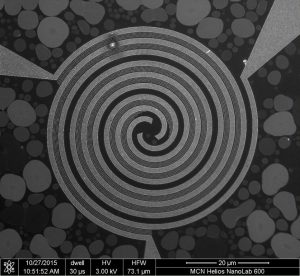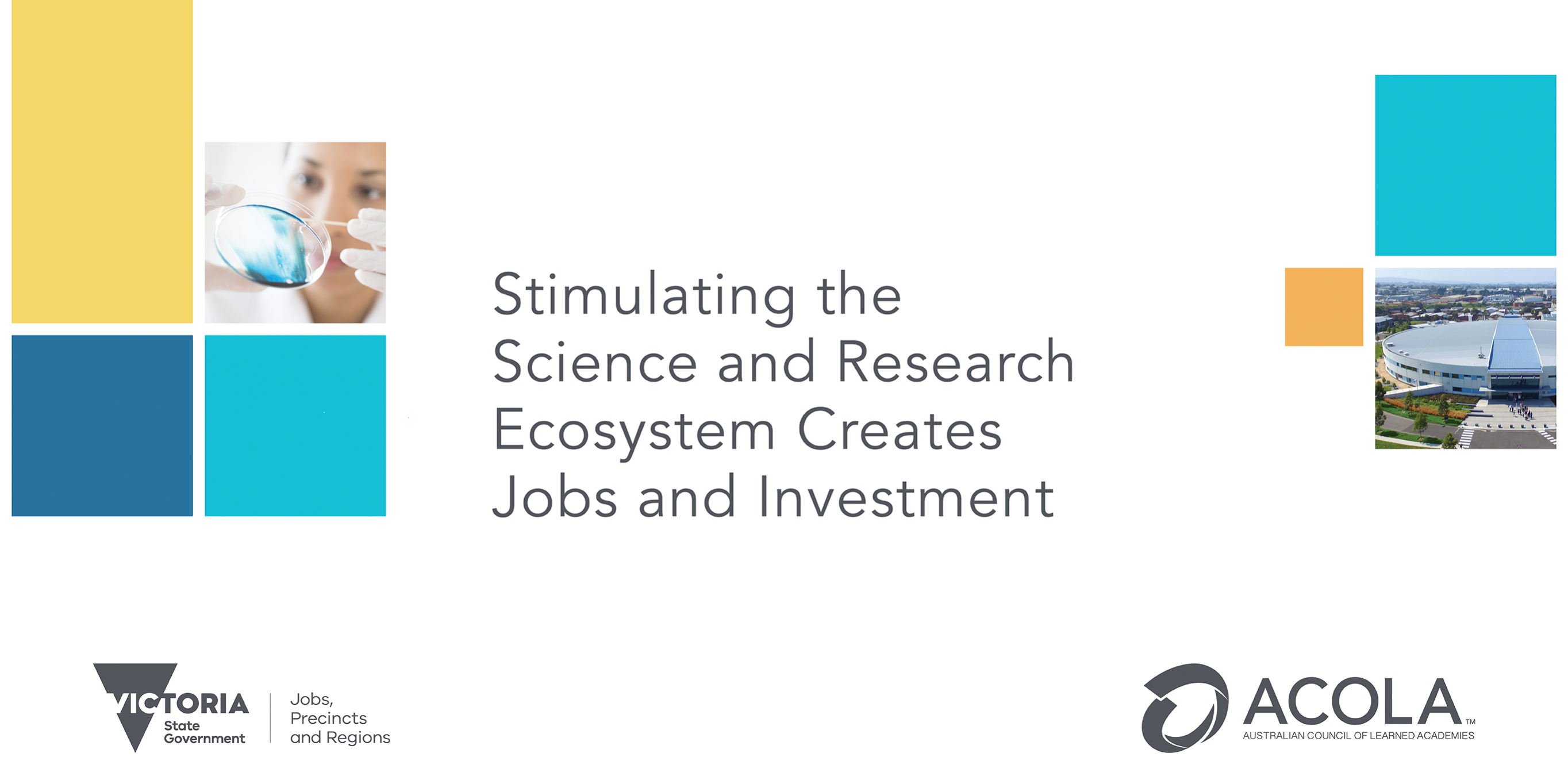Stimulating the science and research ecosystem creates jobs and investment
ACOLA, commissioned by Victoria’s Lead Scientist, Dr Amanda Caples, has produced a report outlining the value of investing in science and research in Victoria, that has brought national relevance. It highlights the broad value of research across the economy including the role current and any future investment can have in Australia’s recovery from COVID-19.
Victoria’s ecosystem comprises a range of actors, with universities playing a crucial part. They provide other organisations, including businesses and governments, with talent, knowledge, tools, technology and global relationships, supporting jobs and growth in Victoria and Australia.
The report takes a broader view, noting how over time the leveraging of many programs and activities at State and Commonwealth levels has resulted in the outcomes attained. Additionally, the report identifies high-level improvements for investment program design.
Over the last two decades, Victoria has focused on building a vibrant and productive science and research ecosystem by investing in research infrastructure (including skills), talent attraction and industry-led strategic capabilities. Major initiatives include facilities that provide access to shared high-technology equipment, such as the Australian Synchrotron and the Melbourne Centre for Nanofabrication (MCN) and attraction of global talent through veski; industry-led collaborative projects with universities.
This report provides the evidence base to support further investment in science and research infrastructure, skills, talent attraction and the use of contestable funding to catalyse industry-led innovation as part of stimulus measures for future jobs and economic prosperity.
Victoria’s world-class science, technology and innovation ecosystem has been stimulated by systematic investment in research infrastructure, skills, talent attraction and the use of contestable funding to catalyse industry-led innovation. This has helped secure Victoria’s position as a knowledge economy, and as a result, supported jobs and prosperity in the long term. Impacts of these investments are noticed in several areas:
Victoria’s Science, Technology and Innovation (STI) Initiative (2000 to 2008) delivered substantial economic impact and jobs
A 2009 evaluation of $470 million STI Initiative funded projects found that even with many projects at an early stage, investments increased gross state product by up to an additional $1.7 billion (2008 prices) and created up to an additional 7,600 one-year fulltime equivalent (FTE) jobs. It led to an increase in research-industry collaborations and export contracts; and cumulative real investment of up to an additional $1.2 billion (2008 prices). The Deloitte evaluation found that “while many of the projects are likely to generate benefits in the future which cannot yet be captured, even at this early stage the economically modelled elements of the Initiative have generated an increase in GSP equivalent to between $2.40 and $3.56 for every dollar of Victorian Government funding provided.
The overall vibrancy of Victorian universities has increased since 2000
Victoria’s share of HERD funding has risen from 22.6% in 2000 to 29% in 2012. Non-government funding for HERD has steadily grown from $82 million in 2000 to $419 million per annum in 2018. In 2018-2019, Victoria’s international education sector generated $12.6 billion in export revenue for the state; supported almost 79,000 FTE Victorian jobs; contributed expertise to Victoria’s research outputs, assisted with international research partnerships, and facilitated an alumni network supporting global research, trade and business collaborations.
Investments have created lasting capability supporting future industries and enabled an environment that has rapidly responded to the coronavirus crisis
Investments in science and research infrastructure and people have led to the establishment of new industries and capability:
- in light-weight manufacturing through a dedicated pilot-scale manufacturing facility (Carbon Nexus) producing aerospace-grade carbon fibre, which has catalysed an employment precinct that supports around 1,400 jobs in the Geelong region.
- in renewable energy by combining next-generation organic solar cell chemistry with polymer technology to attain a leadership position in printable technologies (VICOSC). CSIRO’s Flexible Electronics Laboratory in Clayton is recognised world-wide for its ability to translate laboratory research to large scale, industry-relevant outcomes.
- in characterisation capabilities supporting advanced manufacturing and medical research. The Australian Synchrotron has enabled more than 100 international patents and has supported industry to improve manufacturing processes and undertake clinical trials for new medicines.
The Melbourne Centre for Nanofabrication (MCN) has assisted in the attraction of over $300 million in research investment and has supported industry to develop a range of commercial products.
- for an advanced biomedical imaging network (VBIC), which has attracted $235 million in competitive grants including US$106 million from the National Institutes of Health.
- a fellowship program to support globally competitive researchers and attract them to relocate their research to Victoria (veski). The 27 veski innovation fellows have delivered an 18.4 to 1 economic return on investment through attraction of research funds from national and international sources.
Victorian public research institutions have all contributed to the national COVID-19 response, improving the understanding of the immunology and epidemiology of the virus, developing vaccines and treatments and leading research into the social impact of the pandemic.
As we rebuild the economy, this report provides the evidence base to support further investment in science and research infrastructure, skills, talent attraction and the use of contestable funding to catalyse industry-led innovation as part of stimulus measures for future jobs and economic prosperity.

This investment has produced and strengthened a world-class science and research ecosystem from advanced manufacturing to health and medical research.
Victoria’s science and research ecosystem has, and will continue to have, a vital role in Australia’s economic, social and cultural response and recovery from the COVID-19 pandemic.
While this report has explored the research ecosystem, there has been an emphasis on science and technology fields because this has been the focus of Victoria’s past strategic investments. Specific engagement and investment in critical thinking and creative skills from the humanities and social science sector will be important into the future, including but not limited to supporting the multidisciplinary approaches to the design and adoption of new technologies. For example design students and researchers played an important role in the work of VICOSC in exploring the potential real world applications of flexible solar cells in clothing accessories (e.g. bags), electronic devices (e.g. mobile phones) and buildings (e.g. shade sails and blinds).
As we rebuild the economy, this report provides the evidence base to support further investment in science and research infrastructure, skills, talent attraction and the use of contestable funding to catalyse industry-led innovation aligned with government priorities as part of stimulus measures for future jobs and economic prosperity.
Stimulation of Victoria’s science and research ecosystem in the period 2000-2010 has contributed to the Victorian economy through:

Case Study 1: Australian Synchrotron
Case Study 2: ANFF-VIC Node Central Facility – Melbourne Centre for Nanofabrication
Case Study 3: The Victorian Organic Solar Cell Consortium (VICOSC)
Case Study 4: Victorian Biomedical Imaging Capability (VBIC)
Case Study 5: Carbon Nexus
Case Study 6: veski – inspiring innovation

-
- Download full report (PDF):
- Download full report – accessible (Word):

Reference Group
ACOLA, for its established ability to deliver interdisciplinary evidence-based research draws on specialist expertise from Australia’s Learned Academies. ACOLA convened this valued science and research investment reference group to guide the development of a targeted study that draws input from several disciplines to create a well-considered, balanced and peer-reviewed report. The role of the reference group is to provide expert input, review and provocative thinking. The Review Panel members were asked to declare any conflicts of interest.
| Professor Joy Damousi FASSA FAHA | Dr John Bell FTSE |
| Professor Ian Chubb AC FAA FTSE | Professor Ian Harper AO FASSA |
| Dr Erol Harvey FTSE | Dr Susan Pond AM FTSE FAHMS |
| Professor Elizabeth Webster FASSA |
Project Management
| Dr Michelle Low | Dr Lauren Palmer |
| Ryan Winn |
Project Funding and Support
This project has been kindly supported by the Victorian Government through the Department of Jobs, Precincts and Regions.

Acknowledgement of Country
ACOLA acknowledges the Traditional Owners and custodians of the lands on which our company is located and where we conduct our business. We pay our respects to Elders past, present and emerging.







